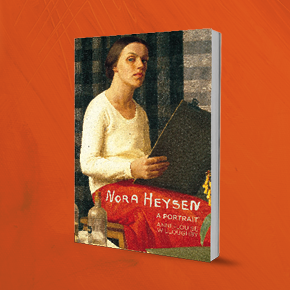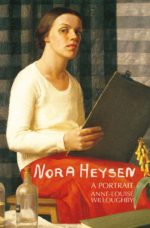Nora Heysen lived her life propelled by an all-consuming drive to draw or paint

Anne-Louise Willoughby is the author of Nora Heysen: A Portrait. She gave a presentation on Nora Heysen in Melbourne on Sunday 10 March as part of NGV Australia’s launch of its new major exhibition Hans and Nora Heysen Two Generations of Australian Art.
In this short extract from her presentation, Anne-Louise takes us through the early part of Nora’s life up to the moment when she won the Archibald Prize.
In 1967 I was nine when I went on a school excursion to the WA Museum. We didn’t have a dedicated art gallery, and on the first landing of the museum’s impressive timber staircase hung Hans Heysen’s Droving into the light. The intense and magical effect that the work had on me, the way Heysen had rendered the light of the Australian bush, transported me, and changed how I responded to art from that moment.
It was not until the early 1990s that I saw a work by Nora Heysen and I was puzzled. The work had strong characteristics of a Hans Heysen but I knew it wasn’t his. When I learned it was by his daughter I was embarrassed that I hadn’t heard of Nora – after all she was the first woman to win the Archibald Prize and Australia’s first woman Official War Artist. But I discovered I wasn’t alone. In art circles Nora was known, but in the wider conversation she was out of view.
There are distinct chapters in Nora’s life from her childhood at The Cedars in the Adelaide Hills to her final days in Sydney.
Throughout these stages there was one prevailing common denominator – Nora lived her life propelled by an all-consuming drive to draw or paint.
Of the eight Heysen children, it was Nora who showed early signs of a natural artistic talent and her father was quick to foster it, and at times his eagerness to guide was not welcome. The teenage Nora working alongside her father in his studio was seen by her mother as a distraction for Hans, and she proceeded to move Nora out. Sallie’s decision to move Nora into her own studio might have been to protect Hans but it was beneficial for Nora that her aspirations were taken seriously at a young age.
When she was twenty-two, Nora held a highly successful solo exhibition raising sufficient funds to cover three years at art school in London. Nora had never been away from her family and to make her own way in London came as quite a shock for the reserved country girl. Her solution was to invite her closest friend Everton Stokes, a sculpture student, to come from Adelaide to London and share her flat.
This was met with deep dismay from her parents who did not approve of Evie, as they believed she was a lesbian and that Nora’s reputation would be harmed. Despite her love and respect for her parents, this resulted in perhaps the first openly defiant act by Nora when she refused to succumb to parental pressure and continued her friendship with Evie, quietly persisting and hoping for their acceptance.
Nora was not only dealing with the disapproval of her parents but with continual adverse criticism from her male teachers and from her father’s friends. It would all take its toll on her buoyant and optimistic approach to hard work. Her teacher at the Central School of Art, Bernard Meninsky, did not make life easy: ‘He said that I had a good idea of drawing and proportion but unfortunately I had been taught the wrong way but it was likely with a few years of training I might be able to see the way he does and do Meninsky drawings.’
It was not only her teachers who challenged Nora. Two men, recommended to Nora by her father while she studied in London, would have a disastrous effect on her sense of worth and artistic ability. The first stinging criticism came from the Royal Academician James Bateman whom Nora had enjoyed listening to in conversation some eleven months earlier with her father in a fellow artist’s London studio. Nora wrote home to her parents on 19 May 1935 that Bateman and his wife had joined Nora for dinner at her studio and he took the opportunity to review her work: ‘I got a gruelling criticism from Bateman. He doesn’t like my work evidently, and hasn’t a good word to say for it.’
Sir Charles Holmes, director of London’s National Gallery, dealt her a blow in late 1936 when he reviewed Nora’s work and delivered ‘a very adverse criticism’. She was aware that there were many ways to paint, to express one’s creativity and vision of life and nature, but the males around her in London were a formidable force. She wrote in a bewildered tone to her parents: ‘There were several items in Holmes’s criticism that I still cannot fathom. He said that my paintings of flowers looked dead and had no life as if I’d taken no pleasure in painting them. I can’t understand it, if there is anything I love doing and find the greatest joy in doing, it’s in painting flowers.’
When she returned from London Nora had been away for over three years and was clear that it was time to separate from her father, there was not enough room for two artists at The Cedars. Nora moved to Sydney and it was late in 1937 that she completed her two entries for The Archibald. Her win was announced in January 1938 just days after her twenty-seventh birthday. It was a contentious win, with the same artists who later attacked Dobell for his 1943 Archibald win attacking Nora, one going so far as to tell her to return the money. The other detractor, fellow entrant Max Meldrum, declared: ‘A great artist has to tread a lonely road. He needs all the manly qualities, courage, strength, and endurance. He becomes great only by exerting himself to the limit of his strength the whole time. I believe that such a life is unnatural and impossible for a woman.’
The Australian Women’s Weekly managed to reduce Nora’s win to a cookery column with the headline “Girl Painter Who Won Art Prize is also Good Cook”.
This is the first biography of Nora Heysen and I have been grateful for the Heysen family’s support over the last four years as I have researched and written this book.
Nora Heysen: A Portrait is my contribution to the ongoing conversation about women in art and their restitution to their rightful place, a conversation that started with the new wave of feminism in the 1970s and which has progressed particularly in the last twenty years in a most meaningful way across the major art institutions in this country.
Nora Heysen: A Portrait is available in all good bookstores and online. The unabridged version of this speech is available to read here.



